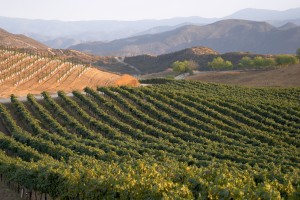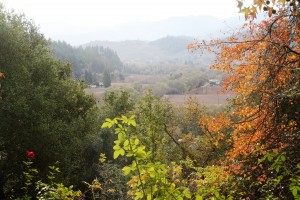In these days of drought, it’s hard to believe that not that long ago the issue facing winery owners was too much rain, rather than not enough. Beginning on January 8, 1995 there was heavy rainfall in Napa and Sonoma counties, causing the Russian River and the Napa River to overflow their banks. This had a major impact on tourism as many likely visitors were scared away. It was not as much of a crisis as it would have been in the summer or at harvest-time, but news reports were pretty frightening anyway: 500 people displaced; roads closed for as much as two days; lost sales for those vintners who only sold at their wineries.
In the midst of all this, Steve was to attend a major conference in his field (that is, information security, which he does when he’s not tasting wine). The conference was in San Francisco. Not only that, but his boss was planning to attend with him. The boss knew that Steve had visited Napa Valley often and suggested that they get to San Francisco a few days before the conference and go wine tasting. This is how Steve became a chauffeur and sommelier for his manager and said manager’s girlfriend, who came along as well.
Now the relationship among the three was quite cordial but it’s never a good idea to get one’s boss stuck on a road that has been flooded out. Keep in mind that many well-known wineries had closed in deference to the rising waters. The Napa River had crested just north of Yountville and the Yountville Cross Road, one of the Valley’s major east-west thoroughfares had been washed out. That meant that several wineries were difficult to reach and a few were inaccessible altogether. Steve well remembers pulling up to the old Silver Oak winery, north of the worst inundation, only to find the doors boarded up with sandbags outside.
So it took some maneuvering to find roads that were dry and wineries that were open. Cell phones weren’t common in those days, so there was no chance of calling ahead and asking if anyone was serving wine that day. Steve’s manager was busily studying a map, but Steve had been around the region often enough that he was able to stick to the relatively higher Silverado Trail and then make excursions onto the crossing roads that appeared open. He also had a good enough mental picture of Napa Valley, simpler in that bygone era, to know where the better wineries were. Or at least he thought he did, which is nearly the same thing. He just pulled onto a road, found an open winery and pretended that was where he was heading all along.
Now there are some lessons to be learned from all this. First, while we don’t recommend visiting Wine Country when there’s a major flood, there is a lot to be said for going wine tasting in rainy or cold weather (which we have done several times since). There are no crowds – heck, there’s almost nobody there – and wine servers can be much more attentive and maybe offer you something they would not consider serving in better times.
Second, wine tasting has become a major tourism industry. Of course, there would be no tourists if there were no wine, but Napa Valley in particular has been described as Disneyland for adults. However, the infrastructure is still farm land. You may not even realize how congested it is until you see Wine Country with nobody in it.
And finally, that visit helped create a better relationship with Steve’s boss, not that it was bad to begin with. Still, like fishermen who can talk for hours about the big one that got away, Steve and his manager were able to tell increasingly harrowing stories about tasting wine in the face of surging flood waters.

